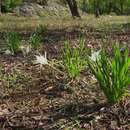en
names in breadcrumbs


Pancratium is a genus of African and Eurasian perennial, herbaceous and bulbous plants in the Amaryllis family, subfamily Amaryllidoideae[2][3][4]
The flowers are large, white and fragrant. The perianth tube and the corona are present. It differs from the similar Hymenocallis in its numerous seeds with a thin black skin.[5] Plants belonging to the genus Pancratium have been found in prehistoric Cretan frescoes.[6]
The name "Pancratium" is derived from the Greek and means "all-strength", probably referring to the strength of a plant that can tolerate extreme climates. Pancratium species often inhabit extremely dry and sandy areas.[7]
Many species have been published using the name Pancratium, but most have been transferred to other genera (Clinanthus, Hymenocallis, Ismene, Proiphys and Stenomesson).[1] Only a few species are cultivated. P. maritimum and P. illyricum being the hardiest for outdoor cultivation, but shy flowering in cool areas. P. zeylanicum is sometimes grown as a hothouse container plant.
As of June 2023, Plants of the World Online of the Royal Botanic Gardens, Kew accepted 24 species in the genus:[1]
Additionally, further species have been recently described:
Pancratium tenuifolium and Pancratium maritimum is pollinated by the moth species Agrius convolvuli.[10][11][12][13][14] In Pancratium maritimum pollination by bees, namely Xylocopa violacea, Apis mellifera, and Anthophora bimaculata, has also been reported.[14] However, it has been stated that bees are not effective pollinators of this species and that it fully depends on hawkmoths for effective pollination.[15]
The moth species Brithys crini feeds on Pancratium maritimum in the larval stage.[16]
Pancratium is a genus of African and Eurasian perennial, herbaceous and bulbous plants in the Amaryllis family, subfamily Amaryllidoideae
The flowers are large, white and fragrant. The perianth tube and the corona are present. It differs from the similar Hymenocallis in its numerous seeds with a thin black skin. Plants belonging to the genus Pancratium have been found in prehistoric Cretan frescoes.